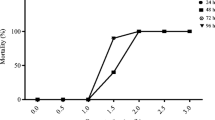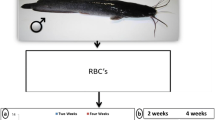Abstract
The present study was conducted to evaluate the safety of long-term dietary curcumin at doses 0.5 and 1 % in Anabas testudineus employing hematological and cytological techniques. The fish were fed with curcumin-supplemented feed for 6 months. Fine blood smears were prepared and subjected to three different staining techniques. The erythrocyte micronucleus frequency (MN) and the cytometric measurements of erythrocytes were determined. Blood from the control and treated fish was subjected to the assessment of several hematological parameters. Also, DNA fragmentation assay on hepatocytes was conducted. The results showed that hemoglobin content, RBC count and hematocrit increased in the curcumin-fed fish compared to control, whereas WBC count, platelet count, mean corpuscular volume, mean corpuscular hemoglobin and mean corpuscular hemoglobin concentration were unaffected. WBC/RBC ratio was lower in the case of curcumin-treated fish. The cytometric measurements revealed no change in the erythrocytes and their nuclei after curcumin treatment. DNA fragmentation assay revealed intact DNA in curcumin-fed group, ruling out the possibility of curcumin-induced DNA damage. The positive control group showed a significant increase in MN frequency compared to negative control and curcumin-fed groups. In fact, the MN frequency decreased in 1 % curcumin-fed group compared to the negative control and 0.5 % curcumin groups. All these indicated a state of well-being of the curcumin-treated fish. Therefore, it is concluded that curcumin could be used as a safe feed ingredient to improve the growth of finfish in aquaculture.



Similar content being viewed by others
References
Adhikari S, Sarkar B (2004) Effect of cypermethrin and carbofuran on certain haematological parameters and prediction of their recovery in a freshwater teleost Labeo rohita (Ham.). Ecotoxicol Environ Saf 58:220–226
Ali FK, El-Shehawi AM, Seehy MA (2008) Micronucleus test in fish genome: a sensitive monitor for aquatic pollution. Afr J Biotech 7:606–612
Allen PC, Danforth HD, Augustine PC (1998) Dietary modulation of avian coccidiosis. Int J Parasitol 28:1131–1140
Antunes LMG, Dias FL, Takahashi CS (1999) Potentiation by turmeric and curcumin of radiation induced chromosome aberration in Chinese hamster ovary cells. Teratog Carcinog Mutagen 19:9–18
Araujo MC, Dias FL, Kronka SN, Takahashi CS (1999) Effect of turmeric and its active principle curcumin on bleomycin induced chromosome aberrations in Chinese hamster ovary cells. Genet Mol Biol 22:407–413
Blasiak J, Trzeciak A, Kowalik J (1999) Curcumin changes DNA in human gastric mucosa cells and lymphocytes. J Environ Pathol Toxicol Oncol 18:271–276
Cao J, Jiang LP, Liu Y, Yang G, Yao X, Zhong L (2007) Curcumin induced genotoxicity and antigenotoxicity in HepG2 cells. Toxicon 49:1219–1222
Chorvatovicova D, Sandula J (1995) Effect of carboxy methyl chitin glucan on cyclophosphamide induced mutagenicity. Mutat Res 346:43–48
Deshpande UR, Gadre SG, Raste AS, Pillai D, Bhide SV, Samuel AM (1998) Protective effect of turmeric (Curcuma longa L.) extract on carbon tetrachloride induced liver damage in rats. Ind J Exp Biol 36:573–577
Duncan DB (1955) Multiple range and multiple F test. Biometrics 11:1–42
Elizabeth K, Rao MNA (1990) Oxygen radical scavenging activity of curcumin. Int J Pharm 58:237–240
Fenech M, Chang WP, Kirsch-Volders M, Holland N, Bonassi S, Zeiger E (2003) Human micronucleus project: detailed description of the scoring criteria for cytokinesis—block micronucleus assay using isolated human lymphocyte cultures. Genet Toxicol Environ Mutagen 534:65–75
Hardy R (1980) Fish feed formulation. Lectures presented at the FAO/UNDP Training Course in Fish Feed Technology, held at the College of Fisheries. University of Washington, Seattle, pp 233–240
Harikrishnan R, Balasundaram C (2008) In vitro and in vivo studies of the use of some medicinal herbals against the pathogen Aeromonas hydrophila in Goldfish. J Aquat Anim Health 20(3):165–176
Harikrishnan R, Nisha Rani M, Balasundaram C (2003) Haematological and biochemical parameters in common carp, Cyprinus carpio, following herbal treatment for Aeromonas hydrophila infection. Aquaculture 221:41–50
Harikrishnan R, Balasundaram C, Dharaneedharan S, Moon YG, Kim MC, Kim JS, Heo MS (2009) Effect of plant active compounds on immune response and disease resistance in Cirrhina mrigala infected with fungal fish pathogen, Aphanomyces invadans. Aquac Res 40:1170–1181
Heddle JA, Hite M, Kirkhart B, Mavournin K, Mac Gregor JT, Newell GW, Salmone MF (1993) The induction of micronuclei as a measure of genotoxicity. Mutat Res 123:61–118
Ibrahim MA, Elbehairy AM, Ghoneim MA, Amer HA (2007) Protective effect of curcumin and chlorophyllin against DNA mutation induced by cyclophosphamide or Benzo[a]pyrene. Z Naturforsch 62c:215–222
Johnson C (2004) Influence of certain plant extract on growth and metabolism of teleosts (Anabas testudineus and Labeo rohita) and a mammal (Rattus norvegicus). Ph.D. thesis, University of Kerala, Thiruvananthapuram, Kerala, India
Kandarkar SV, Sharda SS, Ingle AD, Deshpande SS, Maru GB (1998) Sub chronic oral hepatotoxicity of turmeric in mice—histopathological and ultrastructural studies. Ind J Exp Biol 36:675–679
Kelloff GJ, Crowell JA, Steele VE, Lubet RA, Malone WA, Boone CW et al (2000) Progress in cancer chemoprevention: development of diet-derived chemopreventive agents. J Nutr 130:467S–471S
Kelly MR, Xu J, Alexander KE, Loo G (2001) Disparate effects of similar phenolic phytochemicals inhibitors of oxidative damage to cellular DNA. Mutat Res 485:309–318
Manju M, Sherin TG, Rajeesha KN, Sreejith P, Rajasekharan KN, Oommen OV (2008) Curcumin and its derivatives prevent hepatocyte lipid peroxidation in Anabas testudineus. J Fish Biol 73:1–13
Manju M, Sherin TG, Rajasekharan KN, Oommen OV (2009) Curcumin analogue inhibits lipid peroxidation in a freshwater teleost, Anabas testudineus (Bloch)—an in vitro and in vivo study. Fish Physiol Biochem 35:413–420
Manju M, Akbarsha MA, Ommen OV (2012) In vivo protective effect of dietary curcumin in fish Anabas testudineus (Bloch). Fish Physiol Biochem 38:309–318
Mersch J, Beauvais MN (1997) The micronucleus assay in freshwater mussel, Dreissena polymorpha to in situ monitor genotoxicity in freshwater environments. Mutat Res 393:141–149
Minissi S, Ciccotti E, Rizzoni M (1996) Micronucleus test in erythrocytes of Barbus plebejus (Teleosti. Pisces) from two natural environments: a bioassay for the in situ detection of mutagens in freshwater. Mutat Res 367:245–251
Nagabhushan M, Amonker AJ, Bhide S (1987) In vitro antimutagenicity of curcumin against environmental mutagens. Food Chem Toxicol 25:545–547
Park EJ, Jeon CH, Ko G, Kim J, Sohn DH (2000) Protective effect of curcumin in rat liver injury induced by carbon tetrachloride. J Pharm Pharmacol 52:437–440
Ramýŕez-Tortosa MC, Mesa MD, Aguilera MC, Quiles JL, Baró L, Ramirez-Tortosa CL et al (1999) Oral administration of a turmeric extract inhibits LDL oxidation and has hypocholesterolemic effects in rabbits with experimental atherosclerosis. Atherosclerosis 147:371–378
Reghunathan I, Paneerselvam N (2007) Anti-mutagenic potential of curcumin on chromosomal aberrations in Allium cepa. J Zhejiang Unv Sci B 8:470–475
Ruby JA, Kuttan G, Dinesh Babu KV, Rajasekharan KN, Kuttan R (1995) Anti-tumour and free radical scavenging activity of synthetic curcuminoids. Int J Pharm 131:1–7
Saroch JD, Nisar H, Shrivastav R, Qureshi TA, Manohar S (2012) Haematological studies of mercuric chloride affected freshwater Catfish Clarias gariepinus fed with Spirulina. J Chem Bio Phys Sci Sec B 2:1862–1869
Shah SL, Altindag A (2005) Alterations in the immunological parameters of tench (Tinca tinca, L.) after acute and chronic exposure to lethal and sub-lethal treatments with mercury, cadmium and lead. Turk J Vet Anim Sci 29:1163–1168
Shukla Y, Arora A, Taneja P (2003) Antigenotoxic potential of certain dietary constituents. Teratog Carcinog Mutagen 1:323–335
Sikora EA, Mijewska B-Z, Magalska A, Piwocka K, Mosieniak G, Kalinowska M, Widlak P, Cymerman IA, Bujnicki JM (2006) Curcumin induces caspase-3-dependent apoptotic pathway but inhibits DNA fragmentation factor 40/caspase-activated DNase endonuclease in human Jurkat cells. Mol Cancer Ther 5:927–934
Smerak P, Polivkova Z, Sestakova H, Stetina R, Barta I, Langova M, Turek B, Bartova J (2006) Antimutagenic effect of curcumin and its effect on immune response in mice. Czech J Food Sci 24:72–83
Somasundaram S, Edmund NA, Moore DT, Small GW, Shi YY, Orlowski RZ (2002) Dietary curcumin inhibits chemotherapy-induced apoptosis in models of human breast cancer. Cancer Res 62:3868–3875
Soudamini KK, Kuttan R (1989) Inhibition of chemical carcinogenesis by curcumin. J Ethnopharmacol 27:227–233
Treshiama KC, George J, Kuttan R (1997) Protective effect of curcumin ellagic acid and bixin on radiation induced genotoxicity. J Exp Clin Can Res 7:431–434
Unnikrishnan MK, Rao MN (1995) Inhibition of nitrite induced oxidation of haemoglobin by curcuminoids. Pharmazie 50:490–492
Urbina-Cano P, Morales BL, Herrera MA, Rivera JR, Magna ML, Sanroman R, Rivera A (2006) DNA damage in mouse lymphocytes exposed to curcumin and copper. J Appl Genet 7:377–382
Williams RC, Metcalfec CD (1992) Development of an in vivo hepatic micronucleus assay with rainbow trout, Salmo gairdneri. Comp Biochem Physiol 66:77–82
Wintrobe MM (1967) Clinial hematology. Lea and Febiger. Library of Congress, Print USA, Philadelphia, p 1287
Zhu Y, Chen X, Chen Z, Zeng Y, Shi G, Su Y, Peng X (2004) Curcumin protects mitochondria from oxidative damage and attenuates apoptosis in cortical neurons. Acta Pharmacol Sci 25:1606–1612
Acknowledgments
Senior Research Fellowship from Council of Scientific and Industrial Research (CSIR), New Delhi, to MM, Visiting Professorship from King Saud University, Riyadh, Kingdom of Saudi Arabia, to MAA, and infrastructural facilities under the Special Assistance Program (SAP) of University Grants Commission, New Delhi, to Department of Zoology, University of Kerala, are gratefully acknowledged.
Author information
Authors and Affiliations
Corresponding author
Rights and permissions
About this article
Cite this article
Manju, M., Vijayasree, A.S., Akbarsha, M.A. et al. Protective effect of dietary curcumin in Anabas testudineus (Bloch) with a special note on DNA fragmentation assay on hepatocytes and micronucleus assay on erythrocytes in vivo. Fish Physiol Biochem 39, 1323–1330 (2013). https://doi.org/10.1007/s10695-013-9786-6
Received:
Accepted:
Published:
Issue Date:
DOI: https://doi.org/10.1007/s10695-013-9786-6




